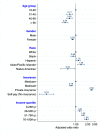Disparities in Social Determinants of Health Among Patients Receiving Liver Transplant: Analysis of the National Inpatient Sample From 2016 to 2019
- PMID: 35936191
- PMCID: PMC9350951
- DOI: 10.7759/cureus.26567
Disparities in Social Determinants of Health Among Patients Receiving Liver Transplant: Analysis of the National Inpatient Sample From 2016 to 2019
Abstract
Background Liver transplantation is the life-saving standard of care for those with end-stage liver disease. Unfortunately, many patients on the liver transplant list die waiting. Several studies have demonstrated significant differences based on disparities in race, gender, and multiple socioeconomic factors. We sought to evaluate recent disparities among patients receiving liver transplants using the latest available data from the National Inpatient Sample (NIS), the largest publicly available inpatient care database in the United States. Methods We performed an analysis of discharge data from the NIS between 2016 and 2019. We identified adult patients with chronic liver disease who underwent a liver transplant using the International Classification of Diseases, 10th revision (ICD-10) codes. Multivariate logistic regression was used to adjust for differences in race, gender, socioeconomic status, and comorbidities among those who received a liver transplant. Results A total of 24,595 liver transplants were performed over the study period. Female gender was independently associated with decreased transplant rates (adjusted odds ratio (AOR) 0.83, 95% confidence interval (CI), 0.78-0.89, P < 0.001). Compared to White patients, Black patients had decreased transplant rates (AOR 0.86, 95% CI, 0.75-0.99, P = 0.034), as did Native Americans (AOR 0.64; 95% CI, 0.42-0.97, P = 0.035). Hispanics and Asian Americans had increased rates of liver transplantation (AOR 1.16, 95% CI 1.02-1.32, P = 0.022, and 1.36, 95% CI 1.11-1.67, P = 0.003; respectively). The increase in income quartile was associated with an incremental increase in transplant rates. Additionally, patients with private insurance had much higher transplant rates compared to those with Medicare (AOR 2.50, 95% CI 2.31-2.70, P < 0.001) while patients without insurance had the lowest rates of transplantation (AOR 0.18, 95% CI 0.12-0.28, P < 0.001). Conclusions Our analysis demonstrates that race, gender, and other social determinants of health have significant impacts on the likelihood of receiving a liver transplant. Our study, on a national level, confirms previously described disparities in receiving liver transplantation. Patient-level studies are needed to better understand how these variables translate into differing liver transplantation rates.
Keywords: gender equity; health care disparities; liver transplant; nationwide inpatient sample (nis); race inequities; social determinants of health (sdoh); socio-demographic disparity.
Copyright © 2022, Mansour et al.
Conflict of interest statement
The authors have declared that no competing interests exist.
Figures
Similar articles
-
Gender Disparities in Hospitalization Outcomes and Healthcare Utilization Among Patients with Systemic Lupus Erythematosus in the United States.Cureus. 2023 Jul 1;15(7):e41254. doi: 10.7759/cureus.41254. eCollection 2023 Jul. Cureus. 2023. PMID: 37529818 Free PMC article.
-
Operative management of rotator cuff tears: identifying disparities in access on a national level.J Shoulder Elbow Surg. 2023 Nov;32(11):2276-2285. doi: 10.1016/j.jse.2023.04.007. Epub 2023 May 26. J Shoulder Elbow Surg. 2023. PMID: 37245619
-
Racial and ethnic disparities in heart transplantation for end-stage heart failure: An analysis of the national inpatient sample (NIS) database.Curr Probl Cardiol. 2024 Mar;49(3):102399. doi: 10.1016/j.cpcardiol.2024.102399. Epub 2024 Jan 17. Curr Probl Cardiol. 2024. PMID: 38242265 Review.
-
Clinical and Sociodemographic Predictors of Mortality in End-Stage Renal Disease Inpatients in Rural Areas of the USA: Evidence From the Nationwide Inpatient Sample.Cureus. 2022 Jun 3;14(6):e25624. doi: 10.7759/cureus.25624. eCollection 2022 Jun. Cureus. 2022. PMID: 35784967 Free PMC article.
-
Gender and Race-Based Health Disparities in COVID-19 Outcomes among Hospitalized Patients in the United States: A Retrospective Analysis of a National Sample.Vaccines (Basel). 2022 Nov 29;10(12):2036. doi: 10.3390/vaccines10122036. Vaccines (Basel). 2022. PMID: 36560446 Free PMC article. Review.
Cited by
-
A comparison of deprivation indices and application to transplant populations.Am J Transplant. 2023 Mar;23(3):377-386. doi: 10.1016/j.ajt.2022.11.018. Epub 2023 Jan 12. Am J Transplant. 2023. PMID: 36695687 Free PMC article.
-
Disparities in Liver Transplant Outcomes: Race/Ethnicity and Individual- and Neighborhood-Level Socioeconomic Status.Clin Nurs Res. 2024 Sep;33(7):509-518. doi: 10.1177/10547738241273128. Epub 2024 Aug 27. Clin Nurs Res. 2024. PMID: 39192612 Free PMC article.
-
Racial Disparities in Candidates for Hepatocellular Carcinoma Liver Transplant After 6-Month Wait Policy Change.JAMA Netw Open. 2023 Nov 1;6(11):e2341096. doi: 10.1001/jamanetworkopen.2023.41096. JAMA Netw Open. 2023. PMID: 37917059 Free PMC article.
-
Resilience, Post-Traumatic Growth, and Transplant Effects-Gender Differences Following Liver Transplantation: A Cross-Sectional Study.Healthcare (Basel). 2024 Dec 26;13(1):24. doi: 10.3390/healthcare13010024. Healthcare (Basel). 2024. PMID: 39791631 Free PMC article.
References
-
- Compressed mortality file 1999-2016 on CDC WONDER online database. [ Apr; 2022 ];http://wonder.cdc.gov/cmf-icd10.html 2017
-
- Ethical principles in the allocation of human organs. [ Apr; 2022 ];https://optn.transplant.hrsa.gov/professionals/by-topic/ethical-consider... 2015
-
- Unequal treatment: confronting racial and ethnic disparities in health care. [ Apr; 2022 ];Nelson A. https://www.ncbi.nlm.nih.gov/pmc/articles/PMC2594273/ J Natl Med Assoc. 2002 94:666–668. - PMC - PubMed
LinkOut - more resources
Full Text Sources

